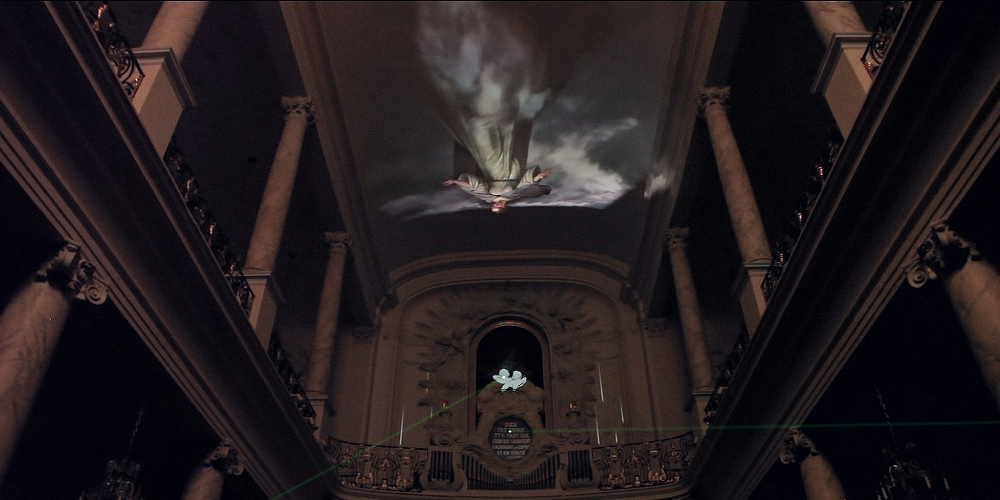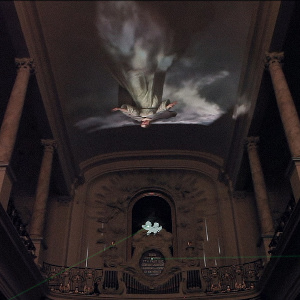
Projection mapping (aka video mapping) denotes the pin-point illumination of three-dimensional objects or architectural elements of a building by means of a beamer. Focusing a ray of light on a particular point makes it possible to dissipate the actual structure of the illuminated element and to fill the projected surface with life. Buildings seem to bend or disassemble, three-dimensional objects move towards the spectators who thus become part of the staged spectacle. To further heighten the realism of the illusion, the projections are often accompanied by tonal elements.
Now, projection mapping is being raised to the next level of artistic development in “Archifon III”, an interactive installation that Czech artists Tomáš Dvořák and Dan Gregor (respective pseudonyms: Floex and Initi) are staging at the grand opening of this year’s Ars Electronica Festival on September 4th at 8:30 PM on Domplatz. Festivalgoers won’t merely behold a building projection; they’ll be able to take laser pointer in hand and participate in the installation. Whenever a laser pointer illuminates an element of St. Mary’s Cathedral (Mariendom), this action will produce an audiovisual reaction. The church is thereby transformed into an interactive, virtual musical instrument.
In this interview, Floex talks about the work’s title and the backstory of this brilliant highlight of the Ars Electronica Festival’s opening.
What does the name “Archifon” mean?
Floex: The name Archifon is a combination of the Czech words architektura (architecture) and fon (phone). We simply wanted to express the basic idea of the installation, which is the connection between architecture and sound.
What’s the difference between Archifon III and its predecessors Archifon I and II?
Floex: Although we’re already presenting the installation for the third time now, the great thing about our work is that each version of Archifon is totally unique. This is due to the fact that every version is profoundly connected to the place where our work is situated. What remains constant is the framework—people aiming laser pointers at the building and getting audio-visual feedback. In this way we create a kind of obscure musical instrument with a building.
What does Archifon III have in store for Ars Electronica festivalgoers?
Floex: Archifon III at Mariendom is a big challenge—not only because Ars Electronica is highly respected, but also because this is the first time we’ll be staging it on the exterior of a building. Also, Mariendom has a very abstract surface, which means we have to find a different approach to our “audio-visual storytelling” than usual. We really like the rosette window, the use of which will be very unique for such an installation. This will be like a natural center of Archifon III.
In our work, we don’t want to emphasize the building’s historical, functional and religious aspects, but we think we can’t totally avoid the spiritual context. So we’re trying to express its essence in a very abstract, universal way. On one hand, there’s the cold, rational side with all the metaphysical constructions we insert into this world, with all the hopes and wishes. That’s the louder side, the one in which time plays a more important role. However, there’s also the other side, a quieter one in which everything is more intuitive and time doesn’t play such an important role. This is the one that connects us all together, and here we use light as a metaphor representing this connection.

Archifon takes the idea of projection mapping to a higher level. How did you come up with the idea?
Floex: Actually it was a nice accident, which maybe shows the positive as well as the creative role of curators. There’s this small multimedia festival called PAF in Olomouc, a city in the northeastern Czech Republic. The curator Alexandr Jančík got the idea of getting me in contact with Dan. He knew about Dan, that he’s highly experienced with projections, mapping, and other interactive projects, and about me as a guy who’s working with interactive music. Plus, he already had an idea about where we could do our first installation. It was a baptismal chapel that had powerful acoustics and loads of interior elements like angel statues, paintings and so on. Somehow it came very naturally. We met for lunch and after lunch the project was almost conceptually finished.
How many people can actively participate at the same time?
Floex: Technically, the installation works with as many people as want to take part, but practically it doesn’t make sense to do the installation with more than 3-5 visitors at one time. Otherwise people get lost in the complexity of the interaction. Anyway, it’s certain that this number of people can make enough noise!
How does it work technically?
Floex: We track the light of the laser pointers via webcams with a motion tracking system. Then we have software custom-written by our programmer, Jakub Koníček, which virtualizes pieces of the façade. Another program we use is called TheBrain, which analyses the resulting data from the other software and sends them to different computers, which take care of the visuals, like animations or generative sequences, and the sounds. For the visuals, we mostly use the program Quartz Composer, and for the sound the programs Max and Ableton. There’s also other small custom-made software written by our programmer, Vaclav Opekar. These programs cover the more complex and specific parts of the installation.
Like its predecessors, Archifon III is staged at a church. Why churches?
Floex: That’s a good question. In a way, it’s just by chance. We don’t really look for churches, because the theme of our installations has nothing to do with religion. We would be just as happy if we could finally produce our installations in or on other buildings. However churches are highly suitable. They are very inspirational as there are often many architectural elements. They’re also often pretty big and it’s not easy to find such big rooms or halls. Size is really important for our installations, because it’s something we need in order to produce a spatial effect.
Archifon III will definitely be one of the high points of the Ars Electronica Festival opening 2014, a must-see event. So be there on Domplatz, September 4, 2014 at 8:30 PM! The rest of the lineup – of the first night and of the entire Festival – is available at https://ars.electronica.art/c/en/programm/.
